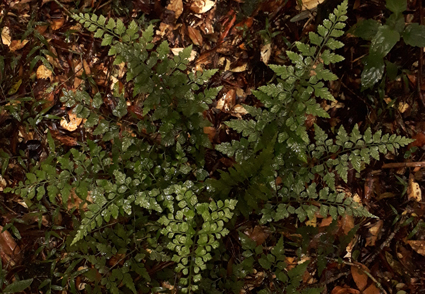Abstract
Asplenium atlanticum (Aspleniaceae), a new species from the Atlantic Forest of Brazil, is described and compared to similar species. It is morphologically related to Asplenium martianum, from which it differs by having deltoid to lanceolate laminae, ovate pinnules with an obtuse apex, elliptic and linear sori, and longer stem scales. It is also similar to Asplenium muellerianum, from which it differs by having longer stem scales, deltoid to lanceolate laminae, and pinnae with an obtuse to acute apex, and to Asplenium pseudonitidum, from which it differs by having shorter and dull petiole, laminae with dentate margins, and pinnules always with obtuse apex. Asplenium atlanticum is known from Paraná, Rio Grande do Sul, and Santa Catarina states. The new species is illustrated, and an identification key to its closely related species is provided.
References
Bachman, S., Moat, J., Hill, A.W., de la Torre, J. & Scott, B. (2011) Supporting Red List threat assessments with GeoCAT: geospatial conservation assessment tool. ZooKeys 150: 117–126. https://doi.org/10.3897/zookeys.150.2109
Brummitt, R.K., Pando, F., Hollis, S. & Brummitt, N.A. (2001) World geographical scheme for recording plant distributions. International working group on taxonomic databases for plant sciences (TDWG). Hunt Institute for Botanical Documentation Carnegie Mellon University, Pittsburg, 137 pp.
Christensen, C. (1905) Index Filicum, sive enumeratio omnium generum specierumque Filicum et Hydropteridum. H. Hagerup, Copenhagen, 800 pp.
Hieronymus, G. (1907) Beiträge zur Pteridophytenflora Südbrasiliens. Hedwigia 46: 57–167.
IUCN (2022) The IUCN Red List of Threatened Species, version 2022-2. IUCN Red List Unit, Cambridge, U.K. Available from: https://www.iucnredlist.org (accessed: 16 December 2022).
IUCN Standards and Petitions Committee (2022) Guidelines for Using the IUCN Red List Categories and Criteria. Version 15.1. Prepared by the Standards and Petitions Committee. Available from: https://www.iucnredlist.org/documents/RedListGuidelines.pdf (accessed: 16 December 2022).
JBRJ—Instituto de Pesquisas Jardim Botânico do Rio de Janeiro. (2022) Jabot – Banco de Dados da Flora Brasileira. Available from: http://jabot.jbrj.gov.br/ (accessed: 16 October 2022).
Lellinger, D.B. (2002) A modern multilingual glossary for taxonomic pteridology. Pteridologia 3: 1–263.
Linnaeus, C. (1753) Species Plantarum 2. L. Salvius, Stockholm, 1200 pp.
Matos, F.B., Labiak, P.H. & Sylvestre, L.S. (2009) A new Brazilian species of the genus Asplenium L. (Aspleniaceae). American Fern Journal 99: 101–105. https://doi.org/10.1640/0002-8444-99.2.101
PPG I (2016) A community-based classification for extant ferns and lycophytes. Journal of Systematics and Evolution 54: 563–603. https://doi.org/10.1111/jse.12229
Prado, J. & Hirai, R. (2014) Biogeography of the Brazilian Atlantic Forest: Evidence from phylogenetic data sets and perspectives for fern and lycophyte studies. Fern Gazette 19: 241–257.
Raddius, J. (1825) Plantarum Brasiliensium Nova Genera et species novae, vel minus cognitae. Typographia Aloisii Pezzati, Florentiae, 322 pp.
Reis, A. (2022) Taxonomia do complexo Asplenium serratum (Aspleniaceae) na Floresta Atlântica brasileira. Museu Nacional – Universidade Federal do Rio de Janeiro, Rio de Janeiro, 77 pp.
Reis, A., Lino, V., Mynssen, C.M. & Sylvestre, L.S. (2022) Asplenium coronatum (Aspleniaceae), a new fern species from the Brazilian Atlantic Forest. Phytotaxa 574: 185–190. https://doi.org/10.11646/phytotaxa.574.2.8
Rothfels, C.J., Sundue, M.A., Li-Yuang, K., Anders, L., Masahiro, K., Schuettpelz, E. & Pryer, K. (2012) A revised family-level classification for eupolypod II ferns (Polypodiidae: Polypodiales). Taxon 61: 515–533. https://doi.org/10.1002/tax.613003
Schneider, H., Russell, S.J., Cox, C.J., Bakker, F., Henderson, S., Gibb, M. & Vogel, J.C. (2004) Chloroplast phylogeny of asplenioid ferns based on rbcL and trnL-F spacer sequences (Polypodiidae, Aspleniaceae) and its implications for the biogeography. Systematic Botany 29: 260–274. https://doi.org/10.1600/036364404774195476
Sehnem, A. (1968) Aspleniáceas. In: Reitz, R. (ed.) Flora Ilustrada Catarinense. Herbário Barbosa Rodrigues, Itajaí, 96 pp.
Stearn, W.T. (1983) Botanical Latin: history, grammar, syntax, terminology, and vocabulary. David & Charles, London and Vermont, 566 pp.
Suissa, J.S. & Sundue, M.A. (2020) Diversity Patterns of Neotropical Ferns: Revisiting Tryon’s Centers of Richness and Endemism. American Fern Journal 110: 211–232. https://doi.org/10.1640/0002-8444-110.4.211
Suissa, J.S., Sundue, M.A. & Testo, W.L. (2021) Mountains, climate and niche heterogeneity explain global patterns of fern diversity. Journal of Biogeography 48: 1296–1308. https://doi.org/10.1111/jbi.14076
Sylvestre, L.S., Costa, T.V. & Lino, V. (2023) Aspleniaceae in Flora e Funga do Brasil. Jardim Botânico do Rio de Janeiro. Available from: https://floradobrasil.jbrj.gov.br/FB90671 (accessed: 12 January 2023).
Thiers, B. (2023) Index Herbariorum: A global directory of public herbaria and associated staff. New York Botanical Garden’s Virtual Herbarium. Available from: http://sweetgum.nybg.org/science/ih/ (accessed: 25 October 2022).
Tryon, A.F. & Lugardon, B. (1991) Spores of the Pteridophyta. Springer-Verlag, New York, 156 pp. https://doi.org/10.1007/978-1-4613-8991-0
Tryon, R.M. & Tryon, A.F. (1982) Ferns and allied plants: with special reference to tropical America. Springer-Verlag, New York, 857 pp. https://doi.org/10.1007/978-1-4613-8162-4
Viane, R. & Van Cotthem, W. (1977) Spore morphology and stomatal characters of some Kenyan Asplenium species. Berichte der Deutschen Botanischen Gesellschaft 90: 219–339.
Xu, K.W., Zhang, L., Rothfels, C., Smith, A., Viane, R., Lorence, D., Wood, K., Chen, C.W., Knapp, R., Zhou, L., Lu, N.T., Zhou, X.M., Wei, H.J., Fan, Q., Chen, S.F., Cicuzza, D., Gao, X.F. & Zhang, L.B. (2020) A global plastid phylogeny of the fern genus Asplenium (Aspleniaceae). Cladistics 36: 22–71. https://doi.org/10.1111/cla.12384


